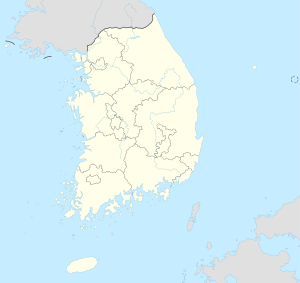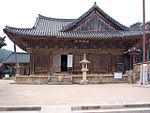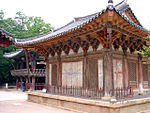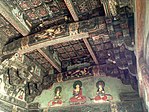Tongdosa
| Tongdosa | |||
|---|---|---|---|
| Korean alphabet : | 통도사 | ||
| Chinese characters : | 通 度 寺 | ||
| Revised Romanization : | Tongdosa | ||
| McCune-Reischauer : | T'ongdosa | ||
| Basic data | |||
| Province : | Gyeongsangnam-do | ||
| Coordinates : | 35 ° 29 ' N , 129 ° 4' E | ||
| map | |||
|
|||
The Tongdo Temple ( Tongdosa , as much as' Temple of 'the redemption of the world through perfect honesty') is one of the main temples of the Buddhist Jogye order (대한 불교 조계종, 大 韓 佛 敎 曹溪 宗). It is located on the southern flank of Chiseosan Mountain near the city of Yangsan in Gyeongsangnam-do Province in South Korea .
Tongdosa is one of the three temples of the three jewels . It stands for Buddha Siddhartha Gautama the founder of Buddhism. The temple is still actively used today as a Seon monastery (선, 禪).
The peculiarity of Tongdosa is that there are no Buddha statues in the open air. This has to do with the fact that relics are kept in this monastery, which are said to come from the religious founder Buddha Siddhartha Gautama . The relics are spread over several stupas ( pagodas ) on the temple grounds.
history
After the Buddhist monk Jajang (자장) returned from a study trip from China, he founded the Tongdosa Monastery in 646. This was during Queen Seondeok's reign, who ruled from 632 to 647. The monastery flourished throughout the period of the united Silla Empire and the subsequent Goryeo Empire. During this period, Buddhism was the state religion. Even in the Joseon Dynasty that followed, when the influence of Buddhism was severely curtailed, Tongdosa retained a comparatively strong position.
The monastery houses a number of relics that are said to go back to the religious founder Siddharta Gautama Shakyamuni . Including a cloak, his begging bowl and a fragment of bone from his skull. The founder of the monastery, Jajang, received these relics for goodbye after studying with 10 other monks in China.
Only one building, Daeungjeon (대웅전, the main Dharma prayer hall), survived the Imjin War (1592–1598); all other buildings are more recent. At the height of its prime, around the middle of the 15th century, Tongdosa is believed to have comprised hundreds of buildings and is believed to have been home to thousands of monks. It is said of the temple candle that for more than 1300 years, without interruption, the next candle was always lit on the burned down candle, so that the flame never went out in these more than 1300 years.
Legend
Legend has it that Jajang founded the monastery near a large pond that was home to nine evil dragons . Jajang urged the dragons to go away by reciting a Buddhist script. But the dragons resisted. He then wrote the Chinese character for fire on a piece of paper and threw it in the air. He hit the pond with his walking stick so that it splashed. The water in the pond then began to boil. Three dragons flew up, lost their orientation, and rang against a cliff . The cliff is now called Dragon Blood Rock ( Yonghyeolam ). Five more kites flew southwest into a valley that is now called the Five Dragon Valley ( Oryonggok ). The last dragon to go blind from the heat vowed if Jajang would spare his life and allow him to stay, to protect the temple for all time. Jajang allowed him to stay in the pond as guardian of the temple. The nine dragon pond ( Guryongji ) still exists next to the main hall of the temple .
Traditional structure
Despite all the individual differences, the structure of a temple follows a largely uniform basic pattern.
During the long history of the monastery, the Buri Gate (Burimun) was rebuilt several times. Today's gate was built towards the end of the Joseon Dynasty. During construction, care was taken that the 3 gates and the prayer hall are exactly in line. On the picture at the beginning of the page, this gate can be seen on the far left of the picture. It is a listed building and is listed as number 252 as a "Material Cultural Object of South Gyeongsang Province".
The monastery today
Korea's largest Buddhist temple, Tongdosa, is often called the temple without Buddhas because there are no Buddha sculptures outside of buildings. Instead, stupas are scattered around the monastery grounds containing the relics brought by the founder Jajang .
The winding road that leads up the mountain slope to the temple is called pine trees that dance in the wind . Spread over 65 buildings there are altars and shrines for almost everything that is sacred to Buddhists. Since the buildings are distributed between forest areas over the mountainside, the size of the monastery is hardly noticeable to the visitor. The monastery complex includes 13 somewhat remote hermitages. The buildings differ significantly in their architectural style. Many of them are not painted or the paint is faded. In one of the buildings there is a mural showing a boat that led the souls of the deceased to the afterlife.
A museum on the monastery grounds shows an outstanding collection of art objects. Today the monastery houses 19 treasures from the monastery history, as well as almost 800 other objects from the cultural history, without any local reference.
On the way to the entrance of the monastery, the first bridge you come across is the Samseongbanwol (Three Arch Bridge). It symbolizes 3 stars and a crescent moon. Sometimes it is also called the bridge of unity .
Importance of the monastery
Tongdosa is one of the five temples called Jeokmyeolbogung (적멸보궁) in Korea . These five temples have relics that the monk Jajang brought back from his study stay in China and that are said to have come from the religious founder Siddharta Gautama Shakyamuni. This is also the reason why Tongdosa represents the Buddha jewel among the three Sambosachal temples (three jewels). The sariri , which are said to come from his ashes, are kept in the Geumgang Gyedan (금강 제단, diamond altar), actually a stupa on a terrace, which mainly serves the Buddhist ceremonies. It is just behind Daeungjeon, the main prayer hall. There is no Buddha statue in the Dharma Hall, as is usual. In its place there is a large window in the wall, which allows a view of the Geumgang Gyedan (diamond altar) directly behind it.
The main Daeungjeon prayer hall in Tongdosa is Korea's National Treasure No. 290.
Picture gallery
See also
Individual evidence
- ↑ a b Tom Le Bas: South Korea . In: Insight Guides . 9th edition. Langenscheidt Publishers, 2010, ISBN 978-981-282-180-5 , pp. 244 .
- ↑ a b c Tongdosa Temple (통도사). In: Visit Korea. Korea Tourism Organization, accessed May 9, 2014 .
- ↑ a b c d e Tongdosa Temple - 통도사. (php) In: Asiam Historical Architecture. Retrieved May 9, 2014 .
- ↑ Tongdo-SA. In: Life in Korea. Life in Asia, Inc., accessed May 9, 2014 .
- ^ A b Tranquility of Tongdosa. In: Visit Korea. Korea Tourism Organization, accessed May 9, 2014 .
- ↑ Jang Eun-hwa: Tongdo-sa: Ancient Temple Embracing Future. The Korea Times, May 15, 2008, accessed May 9, 2014 .
- ↑ Tongdo-SA. In: Life in Korea. Life in Asia, Inc., accessed May 9, 2014 .
- ^ Tongdosa Temple. (No longer available online.) Buddhist-Tourism.Com, archived from the original on December 31, 2013 ; accessed on May 9, 2014 (English). Info: The archive link was inserted automatically and has not yet been checked. Please check the original and archive link according to the instructions and then remove this notice.
- ↑ Jang Eun-hwa: Tongdo-sa: Korea's Head Temple of Buddhist Family. BTN Buddhist Channel, May 8, 2008, accessed May 9, 2014 .
- ↑ Korean Buddhism and Art. (No longer available online.) Archived from the original on May 12, 2012 ; accessed on May 9, 2014 (English). Info: The archive link was inserted automatically and has not yet been checked. Please check the original and archive link according to the instructions and then remove this notice.
Web links
- Tongdosa. Homepage of the temple. Retrieved May 9, 2014 .
- Tongdosa Museum. Retrieved May 9, 2014 (kanuri).
- Buddhist Art Painting by Tongdosa Bulhwaban. Buddhism.org, accessed May 9, 2014 .
















